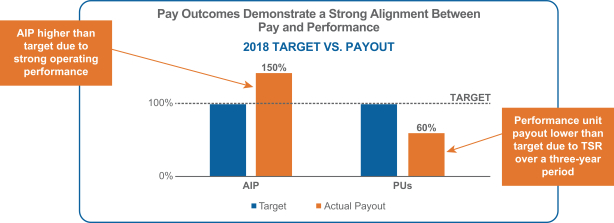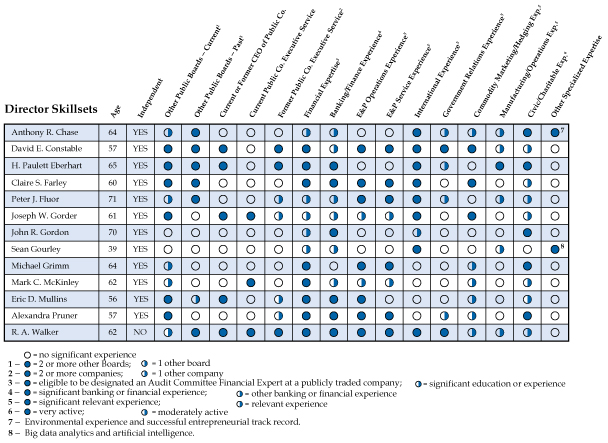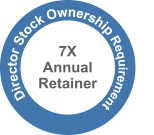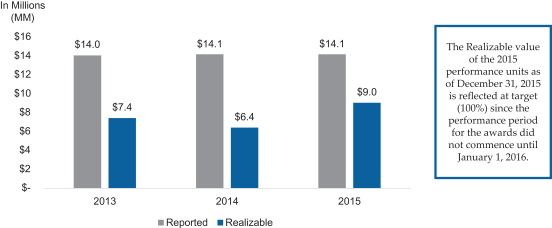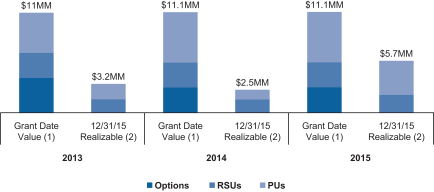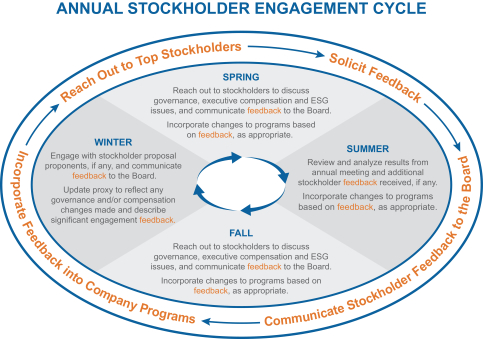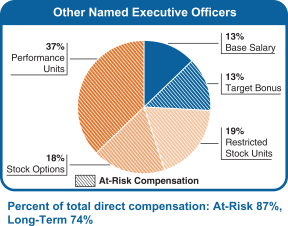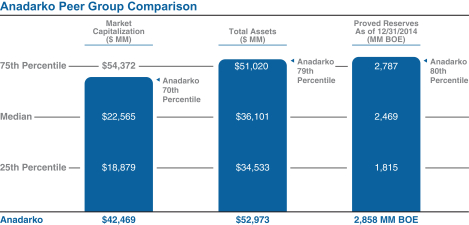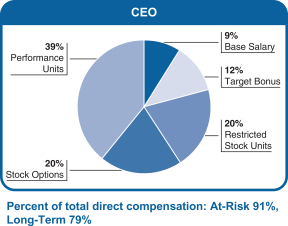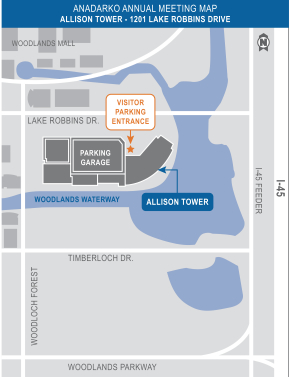Compensation Discussion and Analysis
Tally Sheets. The Committee uses tally sheets in its annual executive compensation review to enhance the analytical data used by the Committee to evaluate our executive officer compensation and to provide the Committee with a consolidated source for viewing the aggregate value of all
elements of executive compensation. The Committee does not assign a specific weighting to the tally sheets in their overall decision-making process, but uses them to gain additional perspective and as a reference in the decision-making process.
ELEMENTS OF OUR COMPENSATION PROGRAMS
Our executive compensation programs include direct and indirect compensation elements. We believe that a majority of an executive officer’s total compensation opportunity should be performance-based; however, we do not have a specified formula that dictates the overall weighting of each element.
As illustrated in the charts below, 79% of the current CEO and 75%, on average, of target total compensation opportunity for the other NEOs is provided through equity-based incentives that are dependent upon long-term corporate performance and stock-price appreciation. Any value ultimately realized for these long-term equity-based awards is directly tied to Anadarko’s absolute and relative stock-price performance and will fluctuate along with stockholder returns.
The charts above are based on the following: current base salaries, as discussed on page 44; target bonus opportunities approved by the Committee in 2015, as discussed on page 47; and the grant date value for the 2015 annual equity awards, as discussed on page 50.
| | |
42 | |  |
Compensation Discussion and Analysis
Direct Compensation Elements
The direct compensation elements are outlined in the table below. The indirect compensation elements are outlined in a table on page 52.

| | | | |
 | | | 43 | |
Compensation Discussion and Analysis
ANALYSIS OF 2015INDIRECT COMPENSATION ACTIONS
The following is a discussion of the specific actions taken by the Committee in 2015 related to each of our direct compensation elements. Each element is reviewed annually, as well as at the time of a promotion, other change in responsibilities, other significant corporate events or a material change in market conditions.
As discussed above, the Committee determined that the target total compensation opportunity for the NEOs should remain flat year-over-year and that no changes should be made to the current base salaries, target bonus opportunities, and target grant value of annual long-term incentive awards.
Base Salary
The table below reflects the base salaries for the NEOs that were approved by the Committee in 2015. As part of its annual review of executive compensation, in October 2015 the Committee determined that no changes should be made to the base salaries for the NEOs.
| | | | | | | | | | | | | | | |
Name | | Salary as of
January 1, 2015($) | | Salary as of
January 1, 2016($) | | Increase |
Mr. Walker | | | | 1,300,000 | | | | | 1,300,000 | | | | | 0% | |
Mr. Gwin | | | | 750,000 | | | | | 750,000 | | | | | 0% | |
Mr. Daniels | | | | 700,000 | | | | | 700,000 | | | | | 0% | |
Mr. Reeves | | | | 700,000 | | | | | 700,000 | | | | | 0% | |
Mr. Kleckner | | | | 625,000 | | | | | 625,000 | | | | | 0% | |
Performance-Based Annual Cash Incentives (Bonuses)
The Annual Incentive Program (AIP) is designed to focus on key performance metrics and targeted levels of performance that are intended to drive differentiating performance year-over-year. All employees of the Company, including our executive officers, participate in the AIP, which is part of our 2012 Omnibus Incentive Compensation Plan (2012 Omnibus Plan) that was approved by our stockholders in May 2012. At the beginning of each plan year, the Committee reviews and approves the performance metrics and targeted levels of performance (the “performance goals”). These performance goals generally align with the Board-approved budget for the year and typically reflect the market and business environment in which we operate. The AIP performance goals are generally intended to work together so that the Company can achieve its long-term strategic performance objectives and provide the best, most direct means of aligning the actions of our executive officers and employees in the short term to position the company to deliver exceptional total stockholder returns over the long term.
Challenges of Setting Performance Goals in a Volatile Environment. Within the exploration and production industry, revenues, operating results, cash flows from operations, capital spending, and future growth rates are highly dependent on the global commodity-price markets. When the AIP goals were set at the beginning of 2015, the duration and magnitude of the decline in commodity prices could not be accurately predicted and the Committee recognized the challenges of setting goals for the full year. At the time the 2015 AIP performance goals were approved, the Committee believed that the targets established were challenging and appropriately required our executive officers and employees to strive for strong performance on key metrics in a lower commodity-price environment.
During the years of higher commodity prices prior to 2015, the Committee established increasingly challenging annual AIP performance goals on key metrics, such as sales volumes and reserve additions, that were designed to generate competitive returns and advance our long-term growth
| | |
44 | |  |
Compensation Discussion and Analysis
objectives. For 2015, the Company substantially reduced its planned capital expenditures to balance investments with available cash in order to manage through the uncertainty of the current market conditions and commodity-price environment. As a result, the 2015 AIP performance goals reflected a more defensive strategy by the Company that focused on preserving and building value to position the Company for future success when the commodity-price environment recovers rather than emphasizing year-over-year growth. As such, unlike previous years, the 2015 AIP performance goals did not reflect higher year-over-year targeted performance.
The 2015 AIP included three additional performance goals and re-allocated the weighting of certain performance goals to provide increased focus on the key areas that are essential to delivering higher-margin sales volumes, improving cost efficiencies, and emphasizing financial discipline, while maintaining a safe work environment and creating stockholder alignment. The structural changes to the AIP for 2015 and the rationale for such changes are illustrated in the following chart.

(1) | For AIP purposes, Capital Expenditures excludes the capital expenditures of WES and WGP, non-cash investments or investments associated with assets expected to be divested and capital that is carried or subsequently reimbursed by another party. EBITDAX/BOE is calculated as earnings before interest, taxes, depreciation, depletion, amortization, and exploration expenses divided by sales volumes for the year. For AIP purposes, it excludes hedging arrangements, gains/losses on sales of assets, major legal-related settlements or expenses and other non-operating income/expense items. EBITDAX that results from acquired production, if any, or from the Company’s planned divestment program is also excluded from the calculation. For AIP purposes, Lease Operating Expense (LOE) excludes the cost of offshore work-overs because of timing uncertainty and magnitude. Controllable General and Administrative Costs (G&A) excludes restricted stock, bonus plans and benefits costs. |
| | | | |
 | | | 45 | |
Compensation Discussion and Analysis
2015 Performance Results. The table below reflects the 2015 performance results against each of the specified targets prior to the Committee’s exercise of significant downward discretion as further discussed below. Each performance goal is capped at 275% and the total AIP score cannot exceed 200%.
| | | | | | | | |
2015 AIP Performance Goals | | Relative
Weighting Factor | | AIP Target
Performance | | AIP
Performance
Results(1) | | AIP
Performance
Score(1) |
Company-Operated Base Sales Volume, MMBOE | | 15% | | 157 | | 163.1 | | 34.4% |
Total Sales Volume, MMBOE | | 10% | | 279 | | 291.7 | | 23.5% |
Reserve Additions (before price revisions, acquisitions and divestitures), MMBOE | | 20% | | 279 | | 407.0 | | 55.0% |
Capital Expenditures, $MM | | 10% | | 5,700 – 6,100 | | 5,425 | | 14.8% |
LOE and Controllable G&A/BOE($) | | 15% | | 6.77 | | 5.48 | | 41.3% |
EBITDAX/BOE($) | | 15% | | 13.40 – 19.05 | | 15.91 | | 15.0% |
Total Recordable Incident Rate (Safety) | | 10% | | 0.34 | | 0.34 | | 10.0% |
Total Stockholder Return | | 5% | | Relative to
Peers | | 9th | | 2.5% |
| | | | | | | | |
Total | | 100% | | | | | | 196.5% |
(1) | The Committee did not make any adjustments to the measured 2015 AIP performance results or overall calculated 2015 AIP performance score. However, see below for a discussion of the Committee’s exercise of significant downward discretion regarding the final approved AIP score. |
The Company delivered very strong operating performance in 2015 despite the challenging commodity markets. The Company performed at or above the targets established for all AIP metrics, with the exception of TSR, while continuing to maintain our strong safety record. Notable performance highlights from 2015 include:
| • | | Sales Volumes — To mitigate the impact of weaker gas prices, the Company delivered high-margin oil production from select core assets exceeding target performance. |
| • | | Operated Base Sales Volumes — The Company created special-projects teams to focus on and deliver improved base sales volume while minimizing capital investment. |
| • | | Reserve Additions — The Company exceeded target on reserve additions. However, extreme downward commodity price volatility during the year resulted in the growth of non-price reserve revisions. The positive non-price reserve revisions were due in part to the benefit of a more favorable service cost environment, resulting in an unintended positive impact on the reserve addition metric. |
| • | | Capital Expenditures — The Company successfully partnered with vendors to lower service and materials costs in all regions and made significant improvements in drilling efficiencies as well as sustainable process improvements. |
| • | | LOE and Controllable G&A — The Company exceeded target due to renegotiations with vendors, reductions in non-essential project spending, a reassessment of processes and procedures designed to reduce operating costs, and a reduction in contract labor and consultant expenses. |
| | |
46 | |  |
Compensation Discussion and Analysis
Significant Downward Discretion Applied to 2015 AIP Award. As reflected in the table above, we exceeded our initial expectations on nearly every operating metric due largely to the hard work and innovation of our employees, including our executive officers. However the Committee recognized that, given the continued challenging commodity-price environment and its impact on stockholders, the uncertainty in setting goals, and the unintended positive impact related to the Reserve Additions metric discussed above, it was appropriate to exercise significant downward discretion to reduce the AIP payout. The Committee determined, with management’s support, to substantially reduce the calculated score from 196.5% to 110% for the executive officers. Due to the significant efforts and contributions of the executive officers in achieving the strong operational performance, the Committee determined that an AIP payout slightly above target was appropriate.
The AIP awards for 2015 for the NEOs are shown in the table below and are reflected in the “Non-Equity Incentive Plan Compensation” column of the Summary Compensation Table. Individual target bonus opportunities are determined based on the executive officer’s position. Executive officers may earn from 0% to 200% of their individual bonus target. Following its annual review of executive compensation in October 2015, the Committee made no changes to the NEO bonus targets for 2016.
| | | | | | | | | | | | | | | | | | | | | | | | | | | | | | | | | | | | | | | | | | | | | |
Name | | Base
Salary
Earnings
for 2015($)(1) | | | | Target
Bonus % | | | | Approved
AIP
Performance
Score | | | | Individual
Performance
Adjustments | | | | Actual
Bonus
Award
($) |
Mr. Walker | | | | 1,350,000 | | | X | | | | 130% | | | X | | | | 110% | | | ± | | | | 0 | | | = | | | | 1,930,500 | |
Mr. Gwin | | | | 778,846 | | | X | | | | 95% | | | X | | | | 110% | | | ± | | | | 0 | | | = | | | | 813,894 | |
Mr. Daniels | | | | 726,923 | | | X | | | | 95% | | | X | | | | 110% | | | ± | | | | 0 | | | = | | | | 759,635 | |
Mr. Reeves | | | | 726,923 | | | X | | | | 95% | | | X | | | | 110% | | | ± | | | | 0 | | | = | | | | 759,635 | |
Mr. Kleckner | | | | 649,039 | | | X | | | | 95% | | | X | | | | 110% | | | ± | | | | 0 | | | = | | | | 678,246 | |
(1) | Individual bonus payments are calculated based upon the actual base salary earnings for the year. The amounts reflected in this column include a total of 27 pay periods, rather than the usual 26, as a result of the Company’s payroll schedule for 2015. |
The Committee did not make individual performance adjustments for any NEO’s 2015 bonus payments in recognition of the team effort necessary to drive the Company’s success.
Section 162(m) Performance Hurdle. In February 2015, the Committee established a baseline AIP performance hurdle for the NEOs of $750 million of Cash Flow from Operating Activities (Net cash provided by (used in) operating activities) as calculated in the Consolidated Statements of Cash Flows, but excluding the effect of any significant (i.e., $100 million or greater) legal settlements/satisfaction of judgments (as described in Management’s Discussion and Analysis of Financial Condition and Results of Operations — Liquidity and Capital Resources — Sources of Cash — Operating Activities) for the fiscal year as published in the Company’s Annual Report on Form 10-K for the year ended December 31, 2015. If this performance hurdle was not achieved, the NEOs subject to Section 162(m) of the IRC would earn no AIP bonuses for the year under the 2012 Omnibus Plan. If the performance hurdle was met, the bonus pool would be funded at the maximum bonus opportunity level for each NEO and the Committee would consider our performance against the AIP performance goals, as well as any other relevant factors, when determining the actual amount of the AIP bonuses to be paid to each NEO. As demonstrated in 2015, the Committee may apply negative discretion in determining actual awards. The Committee does not have the discretion to increase bonuses above funded amounts. The AIP bonus pool was funded for the 2015 performance year because the Company exceeded the established performance hurdle.
| | | | |
 | | | 47 | |
Compensation Discussion and Analysis
Equity Compensation
Our equity-based long-term incentive program is designed to reward our executive officers for sustained long-term share performance. This program represents 75% or more of target total compensation opportunity and includes a combination of equity-based awards (performance units, stock options and restricted stock units) that we believe are performance-based in absolute and relative terms. Pursuant to our equity grant administration procedures established by the Committee, annual equity-based awards for executive officers are typically made at the regularly scheduled Committee meeting in the fall. Equity awards for newly hired executive officers or awards made in connection with promotions are made on the date such awards are approved by the Committee.
The 2015 targeted equity award value was allocated 50% in performance units that reward relative TSR performance and 25% in non-qualified stock options that reward absolute value creation (for a total of 75% long-term equity awards that are performance-based). The remaining 25% is granted in restricted stock units the value of which is tied to our share price and which we believe is necessary to retain executive talent. The Committee believes that this allocation provides a combination of equity-based awards that is performance-based in relative and absolute terms, while also providing a necessary retentive element. For additional details on the terms of these awards see page 61.
Performance Units. The Committee has established TSR as the performance criterion for the Company’s performance unit awards, and believes that a single focus on TSR as the performance criterion for the performance units is appropriate at this time and is consistent with most energy industry peers. TSR provides an effective relative comparison of our performance against an industry peer group. The Committee has discussed the extent to which certain operational or financial measures could be used as relative long-term performance criteria, such as return on capital employed. The Committee concluded that the performance measures included in our AIP are intended to capture the key drivers of the Company’s business, and that such AIP metrics should drive TSR performance over time. However, the Committee will continue to consider whether to include additional performance metrics in the performance unit program.
Performance Unit Peer Group. Following a review of the industry peer group for awards to be granted in 2015, the Committee removed Murphy Oil from the peer group, due to being low in relative size after spinning off its retail marketing business, and replaced it with Chesapeake Energy Corporation. As a result, the peer group for the 2015 performance unit awards was identical to the peer group that was used for conducting the 2015 compensation benchmarking assessment, which is listed on page 40.
If any of the peer companies undergoes a change in corporate capitalization or a corporate transaction (including, but not limited to, a going-private transaction, bankruptcy, liquidation, merger or consolidation) during the performance period, the Committee shall undertake an evaluation to determine whether such peer company will be replaced. At the time these awards were granted, the Committee pre-approved Southwestern Energy, Inc., Cabot Oil and Gas Corporation, Concho Resources, Inc. and Cimarex Energy as replacement companies (in that order).
Performance Unit Performance Period and Payout Opportunity. Beginning with awards granted in November 2014, the Committee eliminated our two-year performance unit program so that all performance unit awards granted in or after 2014 are subject to a three-year performance period. In addition, the Committee reduced the payout opportunity for achievement of TSR performance at the 55th percentile from a payout of 110% to a payout of 100% and reduced the payout opportunities for achievement of all applicable TSR performance levels in the third quartile by 12% to 14% for all new awards. During our prior engagement discussions, certain stockholders suggested eliminating the
| | |
48 | |  |
Compensation Discussion and Analysis
payout opportunity for TSR performance below median. However, the Committee believes that completely eliminating any opportunity would place the Company at a competitive disadvantage in attracting and retaining executive talent as all of the companies in the industry peer group provide for some level of payout below median. The Committee has also considered placing a cap on earned awards at target if absolute TSR is negative for the performance period, regardless of relative TSR. However, as our business is highly dependent on the prices we receive for our oil, natural gas and natural gas liquids, the Committee believes that stockholders are best served by a management team that is highly incentivized to deliver differentiating performance in a challenging industry-wide environment. Accordingly, the Committee believes that placing such a cap on earned awards is not appropriate. In addition, the Committee maintains the ability to apply negative discretion to these awards should the Committee deem such discretionary adjustment necessary.
The following table reflects the payout scale for the annual performance unit program for awards granted in and after November 2014 as well as outstanding performance unit awards granted prior to November 2014:
| | | | | | | | | | | | | | | | | | | | | | | | |
Final TSR Ranking | | 1 | | 2 | | 3 | | 4 | | 5 | | 6 | | 7 | | 8 | | 9 | | 10 | | 11 | | 12 |
TSR Performance Percentile | | 100% | | 91% | | 82% | | 73% | | 64% | | 55% | | 46% | | 36% | | 27% | | 18% | | 9% | | 0% |
| | | Payout as % of Target |
Awards Granted in and after November 2014 | | 200% | | 182% | | 164% | | 146% | | 128% | | 100% | | 80% | | 60% | | 40% | | 0% | | 0% | | 0% |
Awards Granted Prior to November 2014 | | 200% | | 182% | | 164% | | 146% | | 128% | | 110% | | 92% | | 72% | | 54% | | 0% | | 0% | | 0% |
The examples below illustrate how the performance unit payout scale works under two different TSR ranking outcomes, assuming an executive officer received a target award of 20,000 performance units in October 2015 subject to a three-year performance period. Each performance unit earned is a right to receive a cash payment equal to the closing price of one share of our common stock on the date the Committee certifies the performance results for the performance period.
| | | | | | |
| | Relative TSR
Ranking for
Three-Year
Performance
Period | | Payout
Percentage | | Number of
Performance
Units Earned |
Example 1 | | 3rd | | 164% | | 32,800 units
(20,000 x 164%) |
Example 2 | | 10th | | 0% | | 0 units
(20,000 x 0%) |
Stock Options. Stock options typically vest pro-rata annually over three years, beginning with the first anniversary of the date of grant, and have a term of seven years. The exercise price is not less than the market price on the date of grant and repricing of stock options to a lower exercise price is prohibited, unless approved by stockholders.
Restricted Stock Units. The Committee establishes objective performance criteria for each calendar year that must be achieved before any restricted stock units are awarded the following year to executive officers subject to Section 162(m) of the IRC. If the performance criteria are achieved, the Committee may make awards of restricted stock units to the executive officers. The restricted stock units awarded vest pro-rata annually over three years, beginning with the first anniversary of the grant
| | | | |
 | | | 49 | |
Compensation Discussion and Analysis
date. All of the restricted stock unit awards made in October 2015 were made after the Company’s achievement of the 2014 performance criterion, which was to obtain at least $3.1 billion in Cash Flows from Operating Activities (Net cash provided by (used in) operating activities) as presented in the Consolidated Statements of Cash Flows in the Company’s Annual Report on Form 10-K for the year ended December 31, 2014.
Equity Awards Made During 2015
On October 26, 2015, the Committee approved the following awards under our 2012 Omnibus Plan for the NEOs. The target grant value of each of the awards was held flat as compared to awards granted in 2014. These awards, as well as a description of the methodology for calculating the grant date fair value, are included in the Grants of Plan-Based Awards Table on page 62.
| | | | | | | | | | | | | | | | | | | | | | | | | | | | | | | | | | | |
Name | | Total LTI
Grant
Date
Value($) | | Performance
Units (50%) | | Stock
Options (25%) | | Restricted Stock
Units (25%) |
| | | Target #
of Units | | Grant Date
Value($) | | # of Stock
Options | | Grant Date
Value($) | | # of
Units | | Grant Date
Value($) |
Mr. Walker | | | | 11,116,389 | | | | | 77,548 | | | | | 5,547,008 | | | | | 154,615 | | | | | 2,794,960 | | | | | 40,209 | | | | | 2,774,421 | |
Mr. Gwin | | | | 4,457,621 | | | | | 31,096 | | | | | 2,224,297 | | | | | 62,000 | | | | | 1,120,768 | | | | | 16,124 | | | | | 1,112,556 | |
Mr. Daniels | | | | 4,557,779 | | | | | 31,795 | | | | | 2,274,296 | | | | | 63,393 | | | | | 1,145,949 | | | | | 16,486 | | | | | 1,137,534 | |
Mr. Reeves | | | | 3,475,942 | | | | | 24,248 | | | | | 1,734,459 | | | | | 48,346 | | | | | 873,946 | | | | | 12,573 | | | | | 867,537 | |
Mr. Kleckner | | | | 3,626,154 | | | | | 25,296 | | | | | 1,809,423 | | | | | 50,436 | | | | | 911,727 | | | | | 13,116 | | | | | 905,004 | |
Performance Units — Results for Performance Periods Ended December 31, 2015
In January 2016, the Committee certified the performance results for the 2012 and 2013 annual performance unit awards for the three- and two-year performance periods, respectively, that ended December 31, 2015. Under the provisions of these awards, the targeted performance units were subject to our relative TSR performance against a defined TSR peer group. TSR performance is based on the difference between (1) the average closing stock price for the 30 trading days preceding the beginning of the performance period, and (2) the average closing stock price for the last 30 trading days of the performance period, plus dividends paid for the performance period, and further adjusted for any other distributions or stock splits, where applicable.
The Committee believes that these below-target payouts for below-median performance demonstrate that our performance unit program, which represents a significant portion of our overall executive compensation programs, is well-designed to link pay and performance. This year’s payouts show that the values actually earned by the NEOs under our executive compensation programs can differ substantially from the grant date values required to be reported in the Summary Compensation Table and other proxy tables, as our program is designed to pay out at levels aligned with actual performance.
| | |
50 | |  |
Compensation Discussion and Analysis
For the performance periods ended December 31, 2015, the performance results and Anadarko’s ranking, as highlighted, were as follows:
2012 Annual Award — Three-Year Performance Period (January 1, 2013 to December 31, 2015)
| | | | | | | | | | | | | | | | | | | | | | | | |
Final TSR Ranking | | 1 | | 2 | | 3 | | 4 | | 5 | | 6 | | 7 | | APC
8 | | 9 | | 10 | | 11 | | 12 |
TSR | | 32.5% | | 29.9% | | 10.5% | | 8.0% | | 2.1% | | -3.8% | | -24.1% | | -24.3% | | -27.1% | | -36.9% | | -42.6% | | -43.8% |
Payout as % of Target | | 200% | | 182% | | 164% | | 146% | | 128% | | 110% | | 92% | | 72% | | 54% | | 0% | | 0% | | 0% |
|
2013 Annual Award — Two-Year Performance Period (January 1, 2014 to December 31, 2015) |
Final TSR Ranking | | 1 | | 2 | | 3 | | 4 | | 5 | | 6 | | APC
7 | | 8 | | 9 | | 10 | | 11 | | 12 |
TSR | | -4.7% | | -15.7% | | -19.4% | | -21.2% | | -25.1% | | -31.5% | | -34.4% | | -35.8% | | -46.0% | | -49.1% | | -53.9% | | -56.7% |
Payout as % of Target | | 200% | | 182% | | 164% | | 146% | | 128% | | 110% | | 92% | | 72% | | 54% | | 0% | | 0% | | 0% |
The following table lists the number of performance units awarded at minimum, target, and maximum levels and the actual number of performance units earned by the NEOs for the 2012 and 2013 annual performance unit awards for the three-year and two-year performance periods that ended December 31, 2015:
| | | | | | | | | | | | | | | | | | | | | | | | | | | | | | | | | | | | | | | | | | | | | |
| | | 2012 Annual Performance Unit Award | | | | 2013 Annual Performance Unit Award |
Name | | Minimum
# Units | | Target
# Units | | Maximum
# Units | | Actual #
Units
Earned | | | | Minimum
# Units | | Target
# Units | | Maximum
# Units | | Actual #
Units
Earned |
Mr. Walker | | | | 0 | | | | | 17,168 | | | | | 34,336 | | | | | 12,361 | | | | | | | 0 | | | | | 21,998 | | | | | 43,996 | | | | | 20,238 | |
Mr. Gwin | | | | 0 | | | | | 6,119 | | | | | 12,238 | | | | | 4,406 | | | | | | | 0 | | | | | 8,782 | | | | | 17,564 | | | | | 8,079 | |
Mr. Daniels | | | | 0 | | | | | 6,282 | | | | | 12,564 | | | | | 4,523 | | | | | | | 0 | | | | | 8,981 | | | | | 17,962 | | | | | 8,263 | |
Mr. Reeves | | | | 0 | | | | | 4,790 | | | | | 9,580 | | | | | 3,449 | | | | | | | 0 | | | | | 6,874 | | | | | 13,748 | | | | | 6,324 | |
Mr. Kleckner | | | | 0 | | | | | 3,122 | | | | | 6,244 | | | | | 2,248 | | | | | | | 0 | | | | | 2,507 | | | | | 5,014 | | | | | 2,306 | |
Performance Units — Results for 2012 CEO Appointment Award
In connection with his appointment to CEO on May 15, 2012, Mr. Walker received a promotional equity award, including performance units (2012 CEO Appointment Award). The performance units were subject to the same performance criteria as performance unit awards for executive officers, except that the two- and three-year performance periods for the grant to Mr. Walker began on May 15, 2012 and ended on May 14, 2014 and May 14, 2015, respectively. In June 2015, the Committee certified the performance results for the three-year performance period that ended May 14, 2015. For such performance period, the performance result and Anadarko’s ranking, as highlighted, was as follows:
2012 CEO Appointment Award — Three-Year Performance Period (May 15, 2012 to May 14, 2015)
| | | | | | | | | | | | | | | | | | | | | | | | |
Final TSR Ranking | | 1 | | 2 | | 3 | | 4 | | APC
5 | | 6 | | 7 | | 8 | | 9 | | 10 | | 11 | | 12 |
TSR | | 83.0% | | 57.0% | | 42.6% | | 35.6% | | 26.5% | | 18.6% | | 16.0% | | 9.2% | | 9.2% | | 1.8% | | 0.3% | | -25.1% |
Payout as % of Target | | 200% | | 182% | | 164% | | 146% | | 128% | | 110% | | 92% | | 72% | | 54% | | 0% | | 0% | | 0% |
| | | | |
 | | | 51 | |
Compensation Discussion and Analysis
The following table lists the number of performance units awarded at minimum, target, and maximum levels and the actual number of performance units earned by Mr. Walker for the three-year performance period that ended May 14, 2015:
| | | | | | | | | | | | | | | | | | | | |
| | | 2012 CEO Appointment Award |
Name | | Minimum
# Units | | Target
# Units | | Maximum
# Units | | Actual #
Units
Earned |
Mr. Walker | | | | 0 | | | | | 5,254 | | | | | 10,508 | | | | | 6,725 | |
Indirect Compensation ElementsELEMENTS
As identified in the table below, the Company provides certain benefits and perquisites (considered indirect compensation elements) that are considered typical within our industry and necessary to attract and retain executive talent. The value of each element of indirect compensation is generally structured to be competitive within our industry.
| | | | |
Indirect Compensation
Element | | | | Primary Purpose |
Retirement Benefits | | •
•
| | Primary Purpose |
Retirement Benefits | | • Attracts talented executive officers and rewards them for extended service • Offers secure andtax-advantaged vehicles for executive officers to save effectively for retirement |
| |
Other Benefits (for example, health care, healthcare, paid time off, disability and life insurance) and Perquisites | | •
•
| | • Enhances executive welfare and financial security • Provides a competitive package to attract and retain executive talent, but does not constitute a significant part of an executive officer’s compensation |
| |
Severance Benefits | | •
•
| | • Attracts and helps retain executives in a volatile and consolidating industry • Provides transitional income following an executive’s involuntary termination of employment |
Retirement Benefits
Our executive officers participate in the following retirement and related plans:
Anadarko Employee Savings Plans. The Anadarko Employee Savings Plan (401(k) Plan) is atax-qualified retirement savings plan that allows participating U.S. employees to contribute up to 30% of eligible compensation, on abefore-tax basis or on anafter-tax basis (via a Roth or traditionalafter-tax contribution), into their 401(k) Plan accounts. Eligible compensation includes base salary and AIP bonus payments. Under the 401(k) Plan, we match an amount equal to one dollar for each dollar contributed by participants up to six percent of their total eligible compensation. In addition, participants in the Personal Wealth Account (PWA) program, a qualified pension plan, receive an additional four percent contribution of eligible compensation. The 401(k) Plan is subject to applicable IRC limitations regarding participant and Company contributions. Due to IRC limitations that restrict the amount of benefits payable undertax-qualified plans, we also sponsor anon-qualified Savings Restoration Plan. The Savings Restoration Plan accrues a benefit equal to the excess, if any, of Company matching and Personal Wealth Account (PWA)PWA contributions that
would have been allocated to a participant’s 401(k) Plan account each year without regard to the IRC limitation over amounts that were, in fact, allocated to a participant’s account. For additional details on the Savings Restoration Plan see page 70. Amounts deferred, if any, under the 401(k) Plan and the Savings Restoration Plan (collectively, the Savings Plans) by the NEOs are included, respectively, in
| | |
52 | |  |
Compensation Discussion and Analysis
the “Salary” and “Non-Equity“Non-Equity Incentive Plan Compensation” columns of the Summary Compensation Table.Table on page 60. Our matching contributions allocated to the NEOs under the Savings Plans are included in the “All Other Compensation” column of the Summary Compensation Table.
Pension Plans. Anadarko provides funded,tax-qualified retirement benefits for all eligible U.S. employees. Due to IRC limitations that restrict the amount of benefits payable undertax-qualified plans, we also sponsornon-qualified restoration plans that cover the executive officers and certain other employees. The pension plans do not require contributions by participants and a participant becomes vested in his or her benefit at the completion of three years of service as defined in the pension plans. Eligible compensation covered by the pension plans consists of base salary and AIP bonus payments.
Messrs.
| | |
| 54 | |  |















